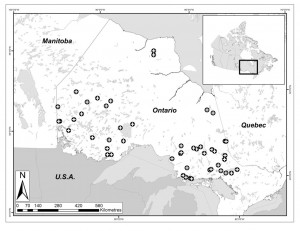Mercury Bioaccumulation in Northern Lakes and Rivers
Mercury is still the most widespread contaminant of concern for public health. In Ontario, for example, approximately 95% of all sampled populations of walleye, contain some individual fish, usually the largest or oldest, that exceed the Canadian consumption guidelines (OMOE 2003). Despite decades and massive efforts at reducing Hg emissions in North America there is mounting evidence that Hg concentration in fish tissue has not declined, but rather appears to be increasing in northern ecosystems. Our research program is a cooperative program of Ontario Ministry of Natural Resources ( T. Johnston), Ontario Ministry of the Environment ( R. Fletcher, S. Bhavsar) and Laurentian (J.Gunn, B. Keller) focused on:
- Assessing trends in Hg in sportfish in northern lakes (includes Ontario Far north) over recent decades
- Understanding the role of changing foodweb (using stable isotopes) and community structure on Hg in key fish species
- Modeling the Impacts of small hydro on Hg in fish in NE Ontario rivers
- Assessing Hg in food fish (both anadromous and non-migratory stocks) used by First Nations communities
Analysis of Hg concentrations in fish has been conducted at the MOE lab in Toronto. The VLWLC is now also setting up its own analytical lab to help facilitate graduate student research projects dealing with Hg.

Distribution of selected study lakes with both current and historic fish Hg concentration data for at least one target fish species. Tang 2011